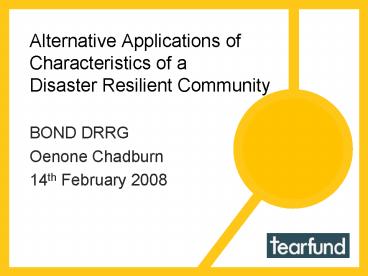BOND DRRG - PowerPoint PPT Presentation
1 / 20
Title:
BOND DRRG
Description:
Needs assessment or gaps analysis. Adjusting the characteristics to become ... Raising the household onto stilts above the level of the annual flood level and ... – PowerPoint PPT presentation
Number of Views:31
Avg rating:3.0/5.0
Title: BOND DRRG
1
Alternative Applications of Characteristics of a
Disaster Resilient Community
- BOND DRRG
- Oenone Chadburn
- 14th February 2008
2
How could you use this resource?
- All stages of the Project Cycle
- Sense of direction vision
- Needs assessment or gaps analysis
- Adjusting the characteristics to become project
indicators - Assessing impact and progress
- Corporate accountability and programme design
(INGOs, International Organisations) - National / International level policy making
3
Bangladesh
- Goal to gently introduce Characteristics to
Tearfund partner - See if Characteristics worked in Bangladeshi
situation - Gather feedback on their usefulness and
understanding - Limited expectations as no previous precedence on
how it would be received
4
Setting
- Allocated ½ day
- Audience was 12-15 DRR field practitioners and
managers - Presented by single person using power point,
flip charts etc - Much of time was dedicated to participatory
discussion
5
Methodology Part A
- Presentation on background of characteristics
(publication NOT distributed at this stage) - Exercise 1 Develop floor map of typical
Bangladesh Village - On coloured card identify hazards and impact of
those hazards on community - On separate coloured card then identify what
activities DRR practitioners would do to reduce
risk, and its desired outcome
6
(No Transcript)
7
Part B
- Publication Distributed
- Time allocated to go through the tables both
individually and collectively - Group Discussion on where the desired outcomes of
their activities matched the Characteristics
8
Results
- Practitioners saw relevance of Characteristics to
Bangladesh situation - Not overwhelmed by the content
- Understood new gaps in their own skills and
practice - Valued its linkage back to Hyogo
- ½ day not long enough!
9
Examples of matching
- Raising the household onto stilts above the level
of the annual flood level and establishing a
flood shelter Thematic Area 5 Characteristic
4.3 (TA5 4.3) - Starting a new school system where annual
flooding coincided with school vacations (so that
family members are together during flooding
season and schooling is not disrupted if school
structure doubles as flood shelter) TA1 5.1 - Ensuring access to safe drinking water and
awareness on its importance during times of
flooding TA3 3.5 and TA4 2.5 - Developing alterative cropping practises (such as
different cropping seasons or flood resistant
variants) TA4 3.5 and TA3 3.5
10
Lessons Learnt
- Exercise useful in defining and debating DRR
- Useful to define where gaps and strengths are
- Looking positively through creating vision was
helpful - Exercise has bias towards table 3,4 and 5
11
Malawi
- Goal to use Characteristics to assess capacity of
partners in Malawi - Designed at a higher level than Bangladesh
- Also designed to help partners compare and learn
from each other
12
Setting
- Allocated ½ day
- Audience was 20 DRR field practitioners and
managers from 6 partners - Presented by single person using power point,
flip charts etc - Much of time was dedicated to participatory
discussion
13
Methodology
- Presentation on background of characteristics
- Introduction to Table 4
- Introduced to TNA approach Knowledge Skills
Attitude - Collectively brainstormed the Knowledge, Skills,
Attitudes required as practitioners to achieve
sub-component 2 of Theme 4
14
Methodology cont...
- Broken into 2 groups to discuss what KSA required
for other sub-components - Brought back collectively to cluster the KSAs
- Ranking exercise as group along a rope on floor
- Closing discussion to see where there collective
strengths and weaknesses were
15
(No Transcript)
16
Results
- Exercise useful in understanding the full scope
of DRR - Saw value of partnerships and networking very
clearly - Saw more clearly the need for specific technical
expertise in DRR - Became apparent how much partners needed to know
and understand the enabling environment
17
Lessons Learnt
- Requires high capacity DRR practitioners to
complete the exercise - Sometimes not always willing to admit in public
forum where weaknesses were - ½ day not long enough!
18
Thank you
19
Exercise A
- Draw a floor map of a typical Bangladeshi village
(20 mins) - Write on separate pieces of paper the disaster
impact which typically occurs in different parts
of the village (10 mins) - On a different piece of paper what community
level activities could be carried out to reduce
risk and what does this look like (30 mins)
20
Exercise B
- Discuss the activities and the resulting change
within the communities one by one, do they
match characteristics found in the tables? - If they do, they classify them under Yes
- If they dont classify them under No and ask
the following - Is this a new Characteristic?
- If not, do we need to re-design the activity so
it achieves a characteristic?































